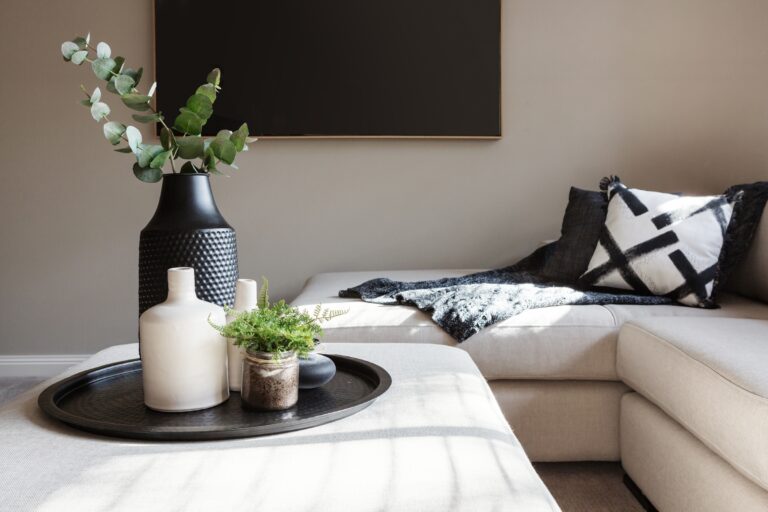If you have a passion for aesthetics, a knack for creating functional spaces, and an entrepreneurial spirit, starting an interior design or interior decorating business can be an exciting and potentially lucrative career choice. But how exactly do you go about starting your own interior design or interior decorating company? In today’s post, we’re diving deep into everything you need to know to get the ball rolling.
Table of Contents
Why start an interior design business?
The benefits of starting your own interior design business include:
Creative freedom
Running your own interior design business allows you to explore your creativity and your love of home design while pursuing projects that align with your vision. Along the way, you can experiment with different styles, materials, and techniques.
No income ceiling
Unlike traditional 9-to-5s with fixed salaries, an interior design business offers the potential for unlimited income. Your earnings are directly tied to the number of projects you take on and the value you provide to your clients. Additionally, there are opportunities to earn commissions from product orders, adding another revenue stream.
Tangible client impact
Helping clients transform their spaces can be incredibly rewarding. Whether you’re designing a cozy home, a sophisticated office, or a luxurious boutique hotel, you have the chance to make a direct and significant impact on people’s lives through your work.
How to start an interior design business in 8 steps
Starting an interior design business requires careful planning and execution. Follow these steps to set yourself up for success as you go from startup mode to launch:
1. Develop your skills and knowledge
While formal education isn’t always necessary, having a solid foundation in interior design principles is crucial. Consider taking courses or earning a degree in interior design to hone your skills. In addition, be sure and stay updated with the latest trends and technologies in the industry through continuous learning and professional development.
2. Create a business plan
A well-thought-out business plan is essential for guiding your business decisions and securing funding if needed. At a high level, your business plan should include:
- Market research: Understand your target market, competitors, and industry trends.
- Business structure: Decide whether you’ll operate as a sole proprietorship, partnership, LLC, or corporation.
- Services offered: Define the range of services you’ll provide, such as residential design, commercial design, or specialized areas like kitchen and bath design.
- Financial projections: Estimate your startup costs, ongoing expenses, and revenue projections.
- Marketing strategy: Outline how you’ll attract and retain clients.
For a more detailed look at interior design business plans and templates to help you write your own, check out our comprehensive guide here.
3. Choose a niche
Specializing, or “niching down,” can help you stand out in an increasingly competitive market. Consider focusing on a specific style, type of space, or client demographic (for example, empty nesters or busy young families). This specialization can make your marketing efforts more effective and attract clients looking for your specific expertise.
4. Register your business and obtain licenses
Register your business name with the appropriate government authorities and obtain any necessary licenses or permits. Requirements vary by location, so check with your local government to ensure compliance. In some states, you may also need a license or certification from a professional interior design organization.
5. Set up your workspace
Your workspace should be a reflection of your design aesthetic and a place where you can meet with clients. Whether you choose to work from a home office or rent a studio, ensure it’s equipped with the necessary tools and resources, including design software and samples of fabrics/materials.
6. Choose the right software
Invest in professional interior design software to streamline your design process, enhance your presentations, and make project management easier and more efficient. Popular options to explore include DesignFiles, AutoCAD, and SketchUp.
7. Build your brand
Your brand is what makes you unique and memorable to potential clients. Start by defining your style and the values you want your business to represent. Don’t worry if you’re not a branding expert—here’s how you can get started:
- Create a simple logo: You don’t need a fancy design right away. Use free online tools like Canva or LogoMaker to create a basic logo that represents your style.
- Choose your colors: Pick a few colors that you love and that represent the vibe you want your business to exude. These colors will be used in your logo, website, and marketing materials.
- Find your voice: Think about how you want to communicate with clients. Are you quirky or serious? Friendly or formal? Keep this tone consistent in your emails, social media posts, and website.
- Build a website: Use easy website builders like Wix or Squarespace to create a simple site. Include a few key sections: a portfolio of your work (even if it’s just photos of your own home), a list of services you offer, and testimonials from anyone you’ve worked with, even if it’s just friends or family. Check out our guide to turning your website into a sales machine here.
Starting small is perfectly okay. Your brand will evolve as you gain more experience and confidence.
8. Market your business
Effective marketing is crucial for attracting clients and growing your business. We recommend using a mix of online and offline marketing strategies, including:
- Social media: Regularly post high-quality images of your work, behind-the-scenes content, and design tips on platforms like Instagram, Pinterest, and Facebook. To get started, check out our articles on Instagram marketing and Facebook marketing for interior designers.
- Networking: Attend industry events, trade shows, and local business gatherings to connect with potential clients and referral partners. Check out our guide to networking and referrals for interior designers here.
- Content marketing: Create valuable content such as blog posts, videos, and downloadable guides to establish yourself as an authority in interior design.
- Email marketing: Build an email list and send regular newsletters to stay in touch with your target audience. Get our email nurturing guide and templates here.
How to grow your interior design company and get more clients
Once your business is up and running, focus on growth and client acquisition. Here are some strategies:
- Client referrals: Encourage satisfied clients to refer you to their friends and family. Offer incentives such as discounts or free consultations for successful referrals.
- Online presence: Optimize your website for search engines (SEO) and increase your visibility. You can either hire an outside agency to help with this or DIY (in which case, check out our handy guide to SEO). You should also regularly update your site with new content and maintain an active blog.
- Professional photography: Be sure and professionally photograph any completed interior design projects so you can add them to your online portfolio.
- Strategic networking: Network with local businesses, such as furniture stores, real estate agents, and contractors. These relationships can lead to valuable referrals and collaborative projects. Don’t forget to refer to our networking and referrals guide for help.
- Client reviews: Collect and share positive client testimonials and reviews on your website and social media platforms to build trust and credibility.
FAQs about starting an interior design business
While you don’t necessarily need a degree to run your own interior design business, having a degree or certification can enhance your credibility and provide valuable knowledge and skills. Some regions may require a license, particularly for commercial design projects. And in others, a license gives you extra privileges. It’s important to check the specific requirements in your area and consider pursuing voluntary certifications from organizations like the National Council for Interior Design Qualification (NCIDQ) to boost your professional standing.
The choice between opening an interior design or decorating business depends on your skills and interests. Interior design typically involves structural changes, space planning, and working with architects and contractors, which requires a deeper understanding of building codes and regulations. Interior decorating focuses more on aesthetics, such as choosing color schemes, furniture, and accessories. If you enjoy working with the foundational elements of spaces, an interior design business may be the right choice. If your passion lies in styling and finishing touches, consider starting an interior decorating business.
Opening your own design business comes with several risks:
Financial Risk: Initial startup costs can be high, and it may take time to build a steady stream of clients. It’s important to have a financial cushion and a clear budget plan.
Market Competition: The interior design industry is competitive, and establishing your brand can be challenging. Differentiating yourself through niche specialization and strong branding is crucial.
Client Management: Dealing with clients can be unpredictable. Some projects may experience delays or changes in scope, affecting timelines and budgets. Effective communication and clear contracts can help manage expectations and protect you and your business.
Business Operations: Managing the business side of things, such as accounting, marketing, and project management, can be overwhelming. Consider outsourcing tasks that aren’t your strength or investing in tools to streamline operations, like DesignFiles.
Starting an interior design business requires careful planning, dedication, and a passion for creating beautiful spaces. By following the steps outlined in this guide and continuously refining your skills and strategies, you will be well on your way toward building a successful and fulfilling career in interior design.
Ready to start an interior design business on the right foundation? Check out DesignFiles.


